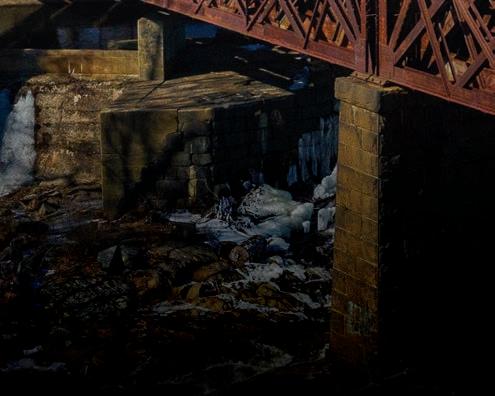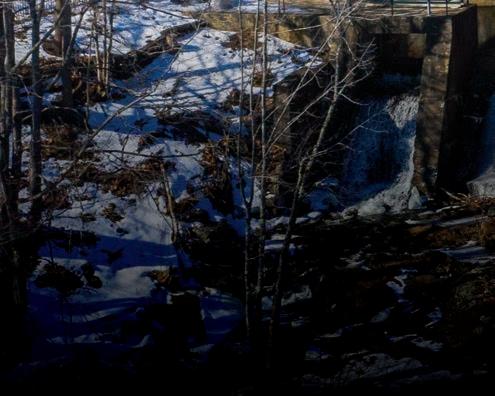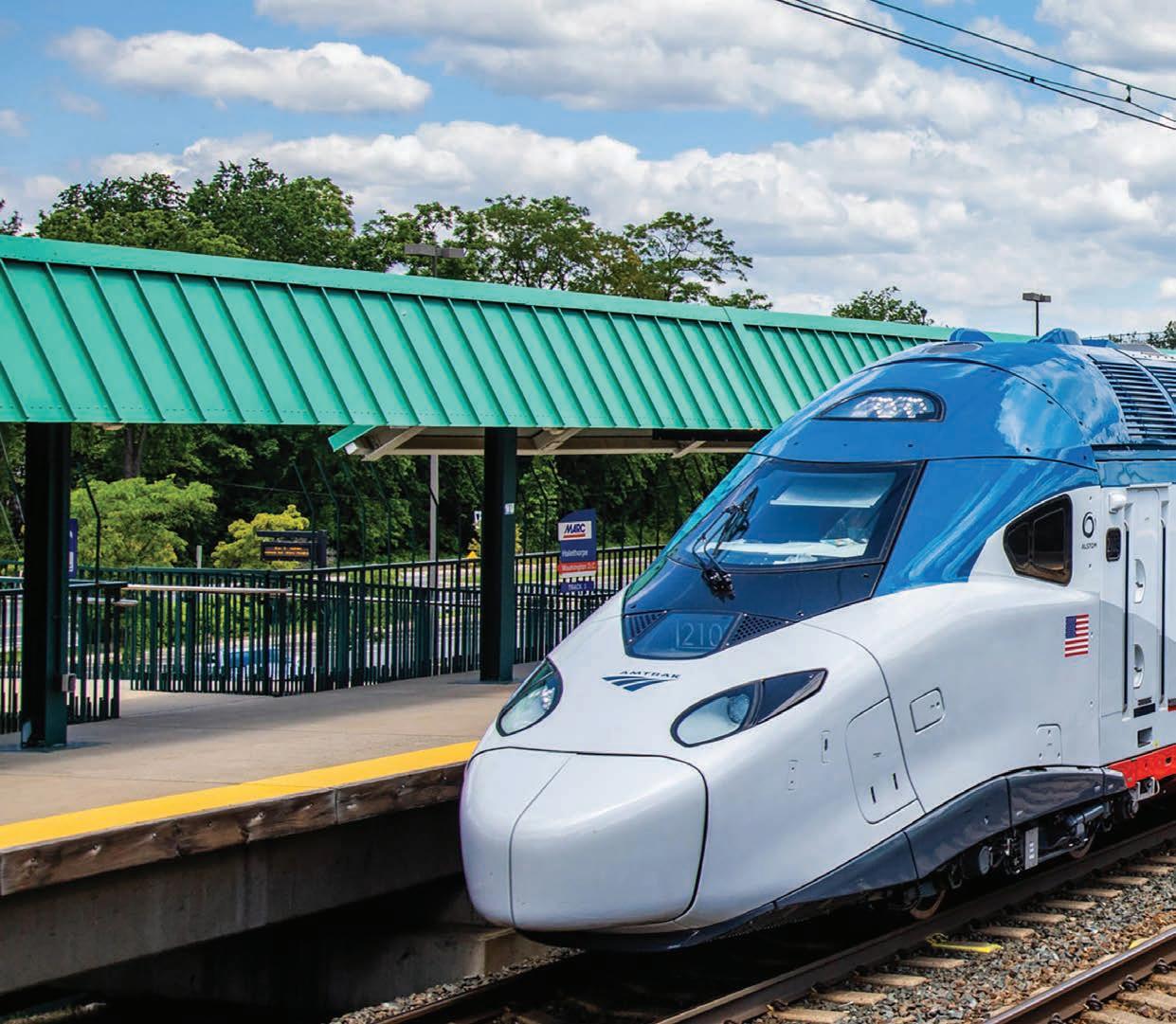
12 minute read
Amtrak at 50, Part 2
A VERY SUBSTANTIAL ROLE


Amtrak’s 50th anniversary comes at a time when passenger rail transportation in the United States, even in the face of a global pandemic that has decimated ridership and farebox revenues, is poised to grow. Among the faithful who have never given up belief in the passenger train (in its many forms), hope and optimism prevail. Activity in the sector, bolstered by an intelligent, knowledgeable President, Joe Biden, who staunchly believes in rail and is a long-time user of the mode, is rising. For Amtrak, it’s an opportunity to increase ridership, add services, and build relevance within the broader transportation spectrum.
Railway Age spoke with Amtrak CEO Bill Flynn and President Stephen Gardner about the company and its future.
“We just cannot say enough about how great our frontline workers have been through this past year,” Flynn says. Adds Gardner, “The company has performed really well through this period, driven by the commitment of our employees, and also our recognition that aggressive action was necessary to deal with a crisis of this magnitude. We had to make a lot of hard decisions as a team, our employees did every day. But as a result, better days are ahead. Our government has been a strong supporter through this, and we’re hopefully starting our way toward a recovery. In the meantime, we made a lot of investments and continue to focus our efforts on the important long-term strategic elements of our plan, which puts us actually in better shape in a way than we were beforehand. Our core



Amtrak’s Bill Flynn and Stephen Gardner share their vision of the future for “America’s Railroad.”
BY WILLIAM C. VANTUONO, EDITOR-IN-CHIEF
construct here is that we think Amtrak can do a lot more for the nation. There’s just a lot more that passenger rail needs to do and can do. We’ve been really focused on putting the company in position to be able to do more.”
Flynn points to several key areas, among them, “the substantial economic impact that Amtrak has and can have as we grow services over time in communities,” he says. “We’re an essential part of the country’s mobility strategy, particularly when you think about constraints that exist in other surface transportation modes, and the huge sustainability impact we can have in terms of whether it’s our carbon footprint or other elements of natural resource consumption, etc. We hit on all of them.”
There’s a strong renewed emphasis on climate change and sustainability in the Biden Administration. What will Amtrak’s role be? “We have a crisis in the country, in the world, driven by climate,” says Gardner. “The largest segment of GHG emissions in the United States is transportation, at 28%. There’s just no way to deal with climate change and reducing GHGs unless rail does more—passenger and freight.”
“We’re excited about the new Administration, and about the conversations we’ve been having with Transportation Secretary Buttigieg and other folks in the Administration, and I would argue, a very good alignment on the Hill,” says Flynn, who points to strong evidence of bipartisanship at recent Congressional hearings, citing questions that were asked about longdistance services and the Northeast Corridor Gateway Project. “Certainly, I believe
Amtrak could be a model for sustainability, going forward,” he says. “We’ve got a good aggressive goal set in terms of GHG, not just that we are a better choice on a perpassenger-mile basis in terms of our carbon footprint, but the work that we’re doing to reduce our carbon footprint so that it improves even on a relative basis.”
“There’s no credible strategy that gets us anywhere without mode shift,” notes Gardner. “To get the emission level reductions we need, we’ve got to build alternative methods. Amtrak intercity service is 47% more efficient than driving or domestic air travel. Rail is the low-carbon, high-volume, high-capacity mode. We’ve got to develop it in the right corridors, in the right places where it can make material impacts. And to do that we need high-quality service, multiple frequencies and competitive trip times. Electric vehicles do not address the fact that this nation’s population is continuing to grow, and that the capacity in the highway network is not sufficient to scale for that increased growth in population and demand. We have the largest rail network in the world of any nation substantially. We have an existing infrastructure and network to use that we can expand for passenger rail, with relatively small impacts on communities, and create that low-carbon capacity to help economic development and opportunity, and provide a clear mechanism for people to make important trips, but at a much lower carbon price. We’ve already reduced our emissions 20% from 2010, and we’re on track for at least a 40% reduction by 2030.
“We’ve got a dynamic and robust network, so what might make sense for long-distance service might not apply in short corridors, and where we have electric traction in place, we have a different model. So it’s clearly going to take a variety of solutions. Amtrak should be at the forefront of looking at these options, and we aim to work with our freight railroad and commuter rail partners and with the Federal Railroad Administration, which we think should be helping to drive this research and development for the industry as well.”
Some of this will require new and/or improved rail infrastructure. One example of such an initiative is already under way, in Virginia, where the commonwealth has partnered with Amtrak, Virginia Railway Express and CSX on an ambitious,


$3.7 billion project to add rail passenger and freight capacity to the Washington, D.C.-Richmond corridor. Among many improvements, it involves constructing some passenger-exclusive right-of-way. (Details, p. 6.)
With the Biden Administration placing greater emphasis on transportation and infrastructure, there’s reason for optimism, albeit cautious, regarding Amtrak funding.
“We are continually being told by our passengers as well as our state partners that Amtrak has a mission to provide services across the country,” says Flynn. “The Biden Administration is supported by a broad coalition on the Hill. There are large swathes of the country where there’s a need for rail service. The population in the South throughout the 50 years that we’ve been operating has doubled. The Western states have grown by 120%. The level of services that we have across many of these communities and regions is the same we had in 1971. The road congestion in many large population centers has increased from when we started. There’s not really room for two more lanes on each interstate, in terms of cost and time and the economic and environmental impacts. The Administration is highly supportive of what Amtrak can provide our country.”
Then there’s the Northeast Corridor, of which Amtrak owns and operates the majority. Some estimates say there’s a $45 billion backlog in state-of-good repair, upgrades and new infrastructure.
“Of the 457 miles of the Northeast Corridor, we own 380 or so,” says Flynn. “Roughly 57 million people live in the Northeast Corridor, 17% or so of the country’s population. There are 2,200 trains a day moving up and down that corridor, on infrastructure that was built in the 1900s. The infrastructure needs are great. A large portion of it has not been addressed for more than a century. The nation got a good deal on infrastructure built in the 1870s, like the Baltimore & Potomac Tunnel— when Grant was President, before the electric light bulb and the telephone—and on the bridges and tunnels in and around New York built in the early 1900s, but they simply need to be replaced. Embedded in that is the Gateway, the 10 miles or so through New Jersey, under the Hudson River, and into Penn Station. On top of that, there are the East River tunnels, and bridges
in Connecticut and over the Susquehanna River. This is tremendous infrastructure that simply needs to be replaced. The price tag is large. Not a lot has been done in the past four years, so four years later everything costs more. We need to move forward on this critical rail infrastructure.”
There have been some reversals in policies enacted by the previous Administration that indicate Gateway will begin to move forward. “It’s an exciting time for the Gateway Program because we do see some strong support from this Administration on moving forward,” says Gardner. “The two states (New York and New Jersey), Amtrak and the railroads have all been working hard for many years. If we want a Northeast Corridor that is designed to handle the next 50 years, not the past 50 years, we’ve got to create capacity so that trains can do more in the region, most particularly commuter service. We’ve got to make this set of investments. Amtrak intends to grow, but there’s massive demand for more New Jersey Transit service, and ultimately more Long Island Rail Road and even Metro-North. The Northeast Corridor has a lot of needs, and it provides an incredible value to the region. For the first time in our history since Penn Central, basically, we have a coherent plan among all the owners and operators for improvement, through some work done by the Federal Railroad Administration with all of the owners and operators and the NEC Commission. We’ve created a plan, NEC FUTURE, on which the USDOT issued an environmental decision a few years ago, and that gives us all a pathway forward. We really haven’t had that throughout our history. The original Northeast Corridor Improvement Program (NECIP) was an important investment, but it didn’t involve the kind of collaboration and the comprehensive view of both the intercity and commuter rail service. There are also 70 freight trains a day (pre-COVID) on the Northeast Corridor. A state-of-good repair investment is necessary to keep the present network reliable.”
“We need a clear federal partner to make our plan happen over a long duration,” notes Gardner. “This isn’t about giving Amtrak and some of the states some money once. This is about a sustained 20-year investment program. It’s just like the problem facing the nation with the interstate highway system. How do you build out a comprehensive system? How do you design something that really meets the needs of the interstate system, the nation, in our case the region? How do you go about doing that, recognizing it’s going to take a long time? You have to have a coherent sequencing of projects and programs. We are very hopeful that through advocacy from the stakeholders, through the Biden Administration, and through the states and commuter railroads, we can get attention to addressing this issue. We’ve done the homework to figure out what needs to be done, how to do it, and how much it’s going to cost. What we now need is commitment, a partnership so that we can launch that program. It’s going to take a while, but it’ll produce fantastic benefits.”
As for the rest of Amtrak’s national




JUST SAY NO to HYDRAULICS

network, “more of America is looking like the Northeast Corridor,” Gardner says. “That’s the key that people forget. Between 1971 and now, 120 million people have been added to this nation, the vast majority of them in the South and in the West. Those communities, those regions, are starting to gain the kind of density and the sort of issues that make rail so important to the Northeast Corridor. Texas and Florida together are 51 million people. Think about the level of service in these two regions. Amtrak has six routes and 11 frequencies serving Texas and Florida, 20 routes and 162 frequencies serving the Northeast Corridor. The Midwest, in places like Ohio, is remarkably underserved for its population and size. We think it’s vital that the nation expand service there and in other regions through a variety of means and services. We need accommodation of long-distance corridor service, and high-speed service where the market makes sense. It’s not one size fits all, but we can and should do more.”
A substantial portion of expanding services to meet demand is co-existing on the rail network with freight railroad hosts, a relationship that has been, since Amtrak was founded, tenuous. “We work closely with our host railroads, and the relationship isn’t the same across each of them,” says Flynn. “We have some very good working relationships that have the ability to grow and expand, and others where it’s still more challenging to grow and provide the services that Stephen just described. They will all play an important part going forward, not just for our company, but for our country. Yet, we’ve got to move forward to ensure that our passenger operations benefit from the statutory preference they’re entitled to. Resolving this will be an essential component of our ability to grow rail services across the country.”
“It’s pretty simple in a sense,” adds Gardner. “We want a strong partnership with freight railroads where they recognize the obligation they have to the public to support passenger service on their networks. In Amtrak’s creation, we essentially became the agent of their fulfillment of their common-carrier obligation for passengers. We believe that, together, we can do amazing things to grow the capacity of passenger and freight. We need both to grow enormously to meet the challenges of the nation. We view our service as an obligation to the nation, as something we need to deliver. We can do so through access to our host railroad network, and we need their support to meet that mission. We are ready to invest to find those common opportunities, but we want to be treated like a customer and a partner performing an important mission for the nation, not as a hostile impingement on their network, which frankly is, in some cases, what we experience.”
Basically, it’s got to be a collaborative effort. The freight railroads and Amtrak have to work together to bring more value to the nation’s rail system. A reliable, perpetual funding stream is a big part of it, in terms of infrastructure, equipment and technology. Such are the elements that need to come together to make it all work.





